Antique Finely Cast/Ornate Japanese Catfish Netsuke Jizai Okimono Brass Figure
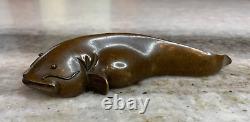

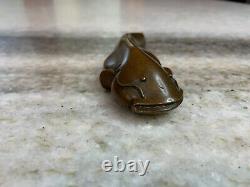
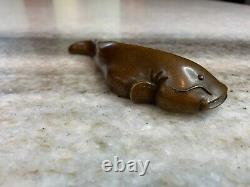


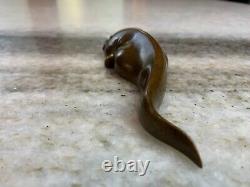
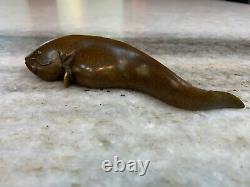



Finely crafted, signed, from Japan! 13.5cm L x 2.6cm T. Which in Japanese mythology is a. The artist captured the ebb and flow of the wiggling fins/tail perfectly...
Feels like this thing is moving.. Is a giant underground catfish. The creature lives under the islands of Japan and is guarded by the god Takemikazuchi. Who restrains the catfish with a stone. When the Kashima-god lets his guard fall, Namazu thrashes about, causing violent earthquakes.
The legend or myth in Japan is that a gigantic namazu (catfish) lives inside or beneath the earth or in the mud. The association of the namazu with earthquake seems to have first occurred in the area around Lake Biwa. The namazu had been depicted in the Otsu-e. ("pictures from the city of Otsu") which were manufactured in that area.
This earthquake-causing creature became associated with the deity and "foundation stone" in Kashima, Ibaraki. According to myth, the god Takemikazuchi. Enshrined at Kashima restrains the catfish underneath a stone kaname-ishi. Perhaps "foundation stone" but maybe more aptly "cap stone".
Widespread connections between catfish and earthquakes in Japan were not present until the late 17th century, and only rose to popularity as symbolically causing or predicting earthquakes during the 19th century. Prior to the 1855 Edo earthquake.
An eel fisherman reportedly spotted unusually active catfish in a river, which he took as a predictor of an earthquake. Later that night, the earthquake struck. The anecdote, recorded in an 1856 chronicle of journalistic reporting on the earthquake, is the earliest known claim that catfish can naturally predict earthquakes. In the 1930s, Japanese seismologists Shinkishi Hatai and Noboru Abe demonstrated that catfish in aquaria showed increased agitation several hours before earthquakes occurred, and were able to predict quakes with 80% accuracy.
Kaminari creating thunder from the posterior. Namazu-e ("catfish prints") were a known item in the 19th century.
Were printed in great quantity following an earthquake near Edo (modern day Tokyo) in 1855. One of the Ansei great earthquakes. Encompass a large variety of scenes, typically depicting the god subduing the earthquake-causing catfish under a sword or the kanameishi stone. The creature is sometimes referred to as just the "earthquake fish" (jishin-no-uo). And despite the text calling it a catfish, the illustration may be that of a dragon. Even though the Namazu was held responsible for the disaster. It was also ironically hailed as a yonaoshi daimyojin (god of "world rectification"), that is to say, a sort of an "avenger of social injustice" which expressed the public's political sentiment at the time.The rich had hoarded their wealth but these were largely disgorged due to the earthquake, and redistributed to the world at large: such is the symbolism of the large gold coins koban. Scattered by the earthquake depicted in the pictures. One picture is printed with a jingle with the refrain " yo-naoshi, yo-naoshi, tate-naoshi " literally "world-fixing, world-fixing, re-building". Which explicitly makes this connection.
This item is in the category "Antiques\Asian Antiques\Japan\Netsuke". The seller is "cosmic_goods" and is located in this country: US. This item can be shipped worldwide.
- Primary Material: Brass
- Color: Brown
- Original/Reproduction: Antique Original
- Region of Origin: Japan
- Age: 1850-1899

